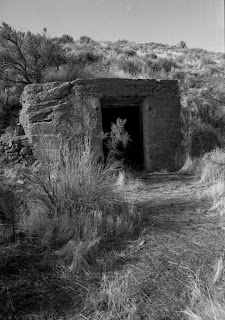
Long before Las Vegas discovered volcanoes and rollercoasters, the old railroad town of Palisade had discovered the importance of entertainment to help put a place on the map.
According to legend, Palisade’s form of entertainment involved a gruesomely realistic shoot-out, held nearly every time a train stopped in town.
During the early 1870s, all passing Central Pacific Railroad trains made a brief stop in Palisade for water and wood. When passengers disembarked to stretch their legs, they encountered a crowd of angry, armed thugs.
Suddenly, a fight would erupt and the rough-looking gunmen began shooting at each other. As the passengers scampered back onto the train, they looked back to see bodies lying on the street in realistic-looking pools of blood.
As the train pulled out, a band of Indians appeared and joined the fracas. Once the train departed, the "dead" miraculously rose from the street and retired to nearby saloons.
The attack was all show. The shooters had fired blanks and the blood was from a local slaughterhouse.
Today, Palisade is a pretty quiet place. So quiet, in fact, that the entire town site was once sold at auction.
In April 2005, a San Francisco-based auction house sold the 160-acre site of the town for $168,750 to an anonymous buyer from the East Coast. The new owner has not announced any plans for the property and remains of the town.
Standing in the cemetery that overlooks the former site of the town, you can hear the rushing waters of the Humboldt River, trains passing through a long tunnel, and the wind whistling through the nearby steep canyon walls for which the area was named.
In the 1870s and 1880s, Palisade was an important railroad stop, at one time serving three different rail lines, including the Central Pacific, the Eureka and Palisade and the Western Pacific.
The town had been established by the Central Pacific Railroad in 1870. Within a few years, it grew to more than 300 residents and competed with Elko and Carlin as a major rail shipping point serving the booming mining camps of Mineral Hill, Eureka and Hamilton.
In 1875, the Eureka and Palisade Railroad was completed, which connected the town to the productive mines of Eureka, located about 90 miles to the south.
The Eureka and Palisade also located its operating headquarters, a depot (shared with the Central Pacific), repair shops and a large ore transfer dock in the community.
For the next 55 years, the narrow gauge rail line transported millions of dollars in ore from the Eureka area, transferring it at Palisade to the Central Pacific (later Southern Pacific) and, after 1910, Western Pacific lines.
By the mid-1880s, the community included saloons, a handful of stores and businesses, hotels, a school and several churches.
As so often happened to towns dependent on mining, Palisade experienced a slow decline, which started in the late 1880s due to the decreasing productivity of Eureka's mines.
In 1910, a major flood swept through the small canyon, destroying a large portion of the town and damaging the train tracks (they were rebuilt). A few years later, fire accelerated the town's demise so that by the time the Eureka and Palisade Railroad ceased operations in 1938, Palisade was already a ghost town.
One of the first things you notice when driving over the hill that drops into Palisade Canyon is the incongruous sight of a few mobile homes on the opposite hillside.
On closer look, however, you can find the remains of about ten structures in the thick sagebrush and tall grass just above the river’s shore. Most are simply the ruins of crude miner's shacks with concrete and brick walls and, in many cases, collapsed wooden and sod roofs.
Wandering through the line-up of partial buildings and foundations, you find other reminders of the town, including the rusted hulk of an old car and other metal scraps. On a hillside above the former main part of the town, you can also spot two tall walls of a more impressive structure.
The cemetery tells the most about Palisade. Still in remarkably good condition because it is maintained by descendents of the town's first residents, the burial ground contains both substantial marble monuments as well as some fine examples of wooden markers.
Of course, as with any Nevada ghost town, be careful not to touch or disturb anything—most of it is private property.
Palisade is located in Northeastern Nevada, about 11 miles south of Carlin. To reach it, travel 9.5 miles south on State Route 278, then 1.5 miles on a marked dirt road.




No comments:
Post a Comment